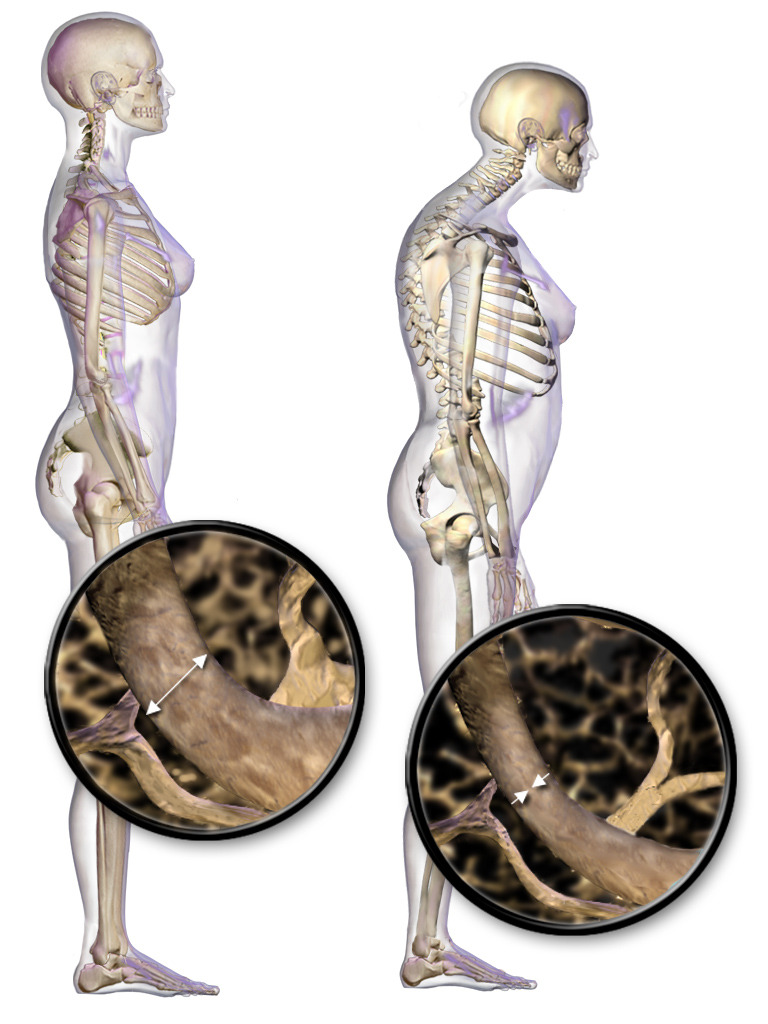Playlist
Show Playlist
Hide Playlist
Osteoporosis with Case
-
Slides Calcium Metabolis.pdf
-
Reference List Endocrinology.pdf
-
Reference List Metabolic Bone Disorders.pdf
-
Download Lecture Overview
00:01 Let's talk about the metabolic bone diseases. 00:03 We'll cover osteoporosis, vitamin D deficiency, osteomalacia and end with Paget's disease of the bone. 00:11 In this case, a 64-year old female presents in the clinic with a history of 3 fractures in the past year with the last one being a month ago. 00:20 Her bone density screening from last year reported a t-score of -3.1 and she was diagnosed with osteoporosis. 00:28 She was advised to quit smoking and alcohol and was given calcium and vitamin D supplementation. 00:35 What is the next best step in the management of this patient? This patient has severe osteoporosis with multiple fractures and very low bone density. 00:44 In fact a bone density of under -2.5 implies the presence of osteoporosis. 00:51 The conclusion here is we have inadequately treated severe osteoporosis and we should prescribe a bisphosphonate for this patient Osteoporosis not responding to lifestyle modifications is usually an indication to commence pharmacotherapy. 01:08 Start with the bisphosphonates, for example alendronate. 01:12 on DEXA scan, this patient has a T-score of -3.1 and for the past year, she has had 3 bone fractures. 01:19 A T-score of greater than -1 is considered normal while between -1 and -2.5 is defined as osteopenia A score of less than -2.5 is diagnostic for osteoporosis which is due to the decrease in the mineral density of bones leading to fragile bones prone to fracture even with minor trauma. 01:41 Risk factors for osteoporosis are numerous. 01:44 They include old age, female gender, postmenopausal states, family history of osteoporosis, ethnicity, low body mass index, low levels of vitamin D and calcium, diet lacking in vegetables and fruits, a sedentary lifestyle in which there is no exercise, smokers, patients who drink alcohol, patients who have a high intake of caffeine and patients who are on drugs like corticosteroids and proton pump inhibitors. 02:15 Risk factors for low bone density in osteoporiosis can be divided into lifestyle or modifiable, non-modifiable and then those related to medications and supplement use Looking at the modifiable factors, alcohol use, immobilzation, low body mass index, low calcium intake, smoking, vitamin D deficiency, wight loss and recurent falls are all things that can be modified to try to improve the patient's osteoporosis and limit the damage to their bones. 02:49 Non-modifiable factors include race and ethnicity, age and gender. 02:54 The classic presentation with osteoporosis is a Caucasian female who is post menopause, who smokes. 03:02 Firs degree relatives with low bone mineral density should have genetic evaluations, they may present with hypophosphatasia and other syndromes like Ehlers-Danlos Syndrome and osteogenesis imperfecta should be ruled out. 03:18 Finally, medications and supplements that may be associated with osteoporosis are numerous. 03:23 The anticonvulsants, antiretrovirals like Tenofovir in patients with HIV, aromatase inhibitors, calcineurin inhibitors in patients who are requiring imune suppression post transplant, depo-medroxyprogesterone preparations and then glucocorticoids. 03:43 This is a dose-dependent relationship so anything more than 5 mg per day of Prednisone or the equivalent for more than three months will increase the patient's risk of developing osteoporosis Further review of medications include heparin, gonadotrophin-releasing hormone agonist which are used in infertility treatment, proton pump inhibitors, thiazolidinediones which are used to treat diabetes Lithium and finally androgen deprivation therapy that one may use to treat patients with prostate cancer Alendronate is prescribed for this patient because she has not really responded to non-pharmacologic therapy up to this point. 04:27 Bisphosphonates inhibit the resorption of bone by osteoclasts and may have an effect on osteoblasts which are responsible for bone mineralization. 04:36 After taking alendronate, always remember to remind patients to remain upright for at least 30 minutes to avoid esophagitis.
About the Lecture
The lecture Osteoporosis with Case by Michael Lazarus, MD is from the course Metabolic Bone Disorders. It contains the following chapters:
- Metabolic Bone Disease
- Case: 64-year-old Woman with History of Fractures
- Risk Factors for Osteoporosis
Included Quiz Questions
Risk factors for the development of osteoporosis include…? (Select all that apply)
- ...menopause.
- ...African ancestry.
- ...3 weeks of treatment with high-dose oral prednisone.
- ...high intake of tea.
- ...older age.
An elderly female patient presents with a T-score of -2.7. She has had 3 fractures in the past year while on vitamin D and calcium supplementation. What is the best next step in management?
- Add a bisphosphonate (e.g. alendronate)
- Increase calcium supplementation
- Increase vitamin D supplementation
- Repeat bone density scan in 6 months
- Advise weight loss
Customer reviews
5,0 of 5 stars
| 5 Stars |
|
5 |
| 4 Stars |
|
0 |
| 3 Stars |
|
0 |
| 2 Stars |
|
0 |
| 1 Star |
|
0 |




